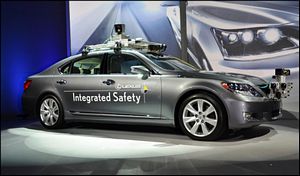|
By accessing or using The Crittenden Automotive Library™/CarsAndRacingStuff.com, you signify your agreement with the Terms of Use on our Legal Information page. Our Privacy Policy is also available there. |

Virtual Co-Pilot In Toyota Cars
|
|---|
|
|
Virtual Co-Pilot In Toyota Cars
Geoff Maxted
DriveWrite
October 12, 2013
Whether we like it or not, Toyota plan to introduce systems in about two years enabling cars to communicate with each other to avoid collision. The system will use radio waves to gather data on the speed of other vehicles thus keeping a safe distance. It showed another system, consisting of cameras, radar and control software, that helps a car maintain position in a lane on its own.
Self-driving systems will be the next big trend for car manufacturers. General Motors' autonomous vehicles, due out by 2020, are expected to drive themselves on controlled-access highways in America and Nissan said last month it would test a Leaf with an advanced driver assist system on Japanese roads. Separately, all-powerful Google is developing technology for self-driving cars as we‘ve already seen.
Toyota's research for developing automated driving systems is focused on reducing traffic fatalities. With the real-time speed information shared via wireless communication, cars can eliminate unnecessary acceleration and deceleration which in turn can reduce traffic congestion and boost fuel efficiency, it is claimed.
The system Toyota has developed incorporates technologies derived from its automated driving research and the company has said it aims to create a virtual "co-pilot" (or nanny) in vehicles that will help drivers avert accidents.
I suppose it is wrong to carp about this technology. Each day, an estimated 3,400 people are killed globally in road traffic crashes apparently, and trends show that by 2030 road traffic injuries will become the fifth biggest killer in the world.
Toyota are also previewing a new pre-crash technology that can steer a vehicle moving at a high speed away from pedestrians when automatic braking alone can't avoid a collision. This new system will be available after 2015, the company said. Thus we see the ever quickening march towards self-driving cars.
It won’t be long now.
Unquestionably, the demand will be there. The roads are not just filled with petrol heads. It is hard to get off the fence on this one. We don’t want people dying on the roads but we also don’t want to be swaddled in cotton wool. Although this technology will be available in a scant few years, no doubt it will take many, many years before it is widely used. In the meantime motor racing circuits should be rubbing their hands together with glee. If the roads are a no-go area for those of the petrol persuasion the circuits should do a roaring trade in track day sales!



















